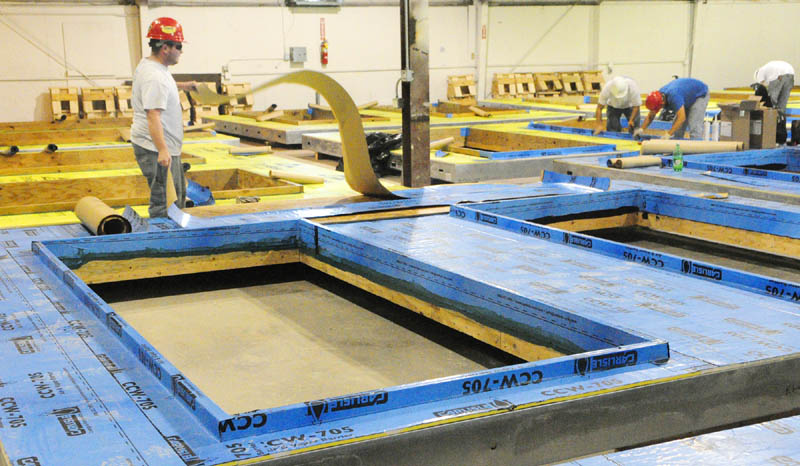PORTLAND — The outside walls of the new regional hospital in north Augusta are taking shape on the floor of a warehouse that echoes with the ring of screw guns.
“That’s music to my ears,” said Ken Porter, president of Porter Panel and Truss, the managing partner in a joint venture that helped secure the hospital’s drywall work for Maine firms.
The exterior walls of the new 640,000-square-foot MaineGeneral Medical Center start with galvanized steel studs, then receive sheathing, waterproofing and heavy wooden framing for large windows. The glass is installed on site.
The prefabrication process is faster, safer and less expensive, Porter said.
“All those passes that would routinely take place on the face of the building, they all take place in here,” Porter said, watching a trio of workers assemble one of the three or four frames they would finish that day. “Instead of these guys hanging off the building, they’re here in a much safer environment.”
That translates to a savings of 50 percent on the firm’s workers’ compensation insurance premiums, he said, “and the quality is so much easier to control.”
It also leads to savings on the exterior wall construction costs.
A dozen people worked on the project last week at the warehouse. Sometimes, it’s many more, Porter said.
The firm, which helped create PDZL — which stands for Porter Panel & Truss, Dirigo Drywall, also in Portland; Zimba Co., of Fairfield; and Landry & Sons Acoustics of Lewiston — is crafting 237 exterior panels.
Sizes range from 16-by-16 feet to 30-by-16 feet. Workers from Standard Waterproofing of Waterville apply the vapor barrier in another area of the Portland warehouse.
The trailer carrying the panels to Augusta is so large it can be moved only in daylight and requires special permits and escorts.
One stack of panels awaited delivery, and the timing is carefully monitored.
“It’s just as the schedule demands,” Porter said. “The panels show up and we install them.”
Porter said the firm also likes deliveries of its materials “just in time” for construction. The schedule is worked backwards, allowing the firm to figure out when the structural steel would be completed on site and the panels would be needed.
Don Lessard is Porter’s on-site superviser in Augusta. Workers from ADW Architectural Doors & Windows of Westbrook install the windows, on site. That is followed by the exterior finish, which is either brick or another product.
The first exterior panel was installed on the building Jan. 17, and the last probably will be put up by the middle of this month, Porter said.
Other walls on the building are made of windows.
The joint-venture company also is prefabricating the interior headwalls for patient rooms and the bathrooms. That work is being done on the terrace level of the new hospital.
As many as 150 people can be involved in the drywall work, counting those on the hospital site and those at the Portland warehouse on Presumpscot Street.
“Speed is the greatest advantage of prefabrication,” Porter said.
Porter first made extensive use of it for the construction of Hollywood Slots Casino & Hotel in Bangor.
“We realized at that point we wanted to keep doing it,” he said. “Doing this panel prefabrication has basically kept us alive during the recession. It’s been a lifeline.”
The panelizing process, good weather, and other favorable conditions have propelled the hospital construction faster than anticipated. It is now scheduled to open in December 2013.
MaineGeneral Medical Center’s 192-bed hospital is the largest project Porter has worked on, and it’s allowing the firm, which started as Porter Drywall, to want to work on similar projects.
“There’s another large hospital project we hope to be a part of,” Porter said.
Porter described commercial drywallers as basically commercial carpenters. However, the materials they use may be a little different. For instance, the hospital’s interior walls must be noncombustible, so metal framing is used.
In order for the building to be silver LEED (Leadership in Energy and Environmental Design)-certified for health care standards, materials must be obtained from within a 500-mile radius, said Jim Cram, sales director and LEED Green Associate at Porter. The steel comes from a mill in Connecticut.
There are other standards as well, including a requirement that a high percentage of waste be recycled.
Once the $312 million hospital is completed, MaineGeneral Medical Center expects to use 12 million gallons less water each year and see a $900,000 reduction in heating and cooling cost, according to a hospital estimate.
Send questions/comments to the editors.




